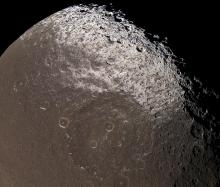Listen to today's episode of StarDate on the web the same day it airs in high-quality streaming audio without any extra ads or announcements. Choose a $8 one-month pass, or listen every day for a year for just $30.
You are here
Moon and Saturn
There are only two bodies in the solar system where rain falls on a solid surface, carving riverbeds and filling lakes and seas. One of them is Earth. The other is Titan, the largest moon of Saturn. But there’s one big difference between them: Titan is more than 300 degrees colder than Earth is, so the liquid that falls from its skies is not water, but methane.
Titan is the second-largest moon in the solar system — about as big as the planet Mercury. But it ranks second to none in the “intriguing” category.
For one thing, it’s the only moon with a thick atmosphere — more than half again as thick as Earth’s. And like Earth, the atmosphere supports a cycle of rainfall and evaporation.
The rains fill lakes near Titan’s poles, but just how that works is unclear. It could be that the lakes remain at least partially full year-round, and the rains just top them off. Or the lakes may dry up during summertime and refill during winter.
Perhaps most intriguing of all, Titan contains many of the building blocks for life — not just methane, but many of the other compounds from which life arose on Earth. So Titan may well be a chillier version of an early Earth — a world with all the ingredients for life.
Saturn stands near the upper left of our own moon this evening. It looks like a bright star. Through a small telescope, Titan looks like a tiny star quite close to the giant planet.
More about Saturn and the Moon tomorrow.






